My Tips For Decorating Shelves, Bookcases, and Picture Ledges
I am still thoroughly enjoying my new picture ledges in the sitting room that I built and filled with all kinds of colorful and fun artwork. If you missed that project, you can find those details here. I’ll admit that I walk through that room a couple of times a day just specifically to look at the shelves and the artwork on them. 😀
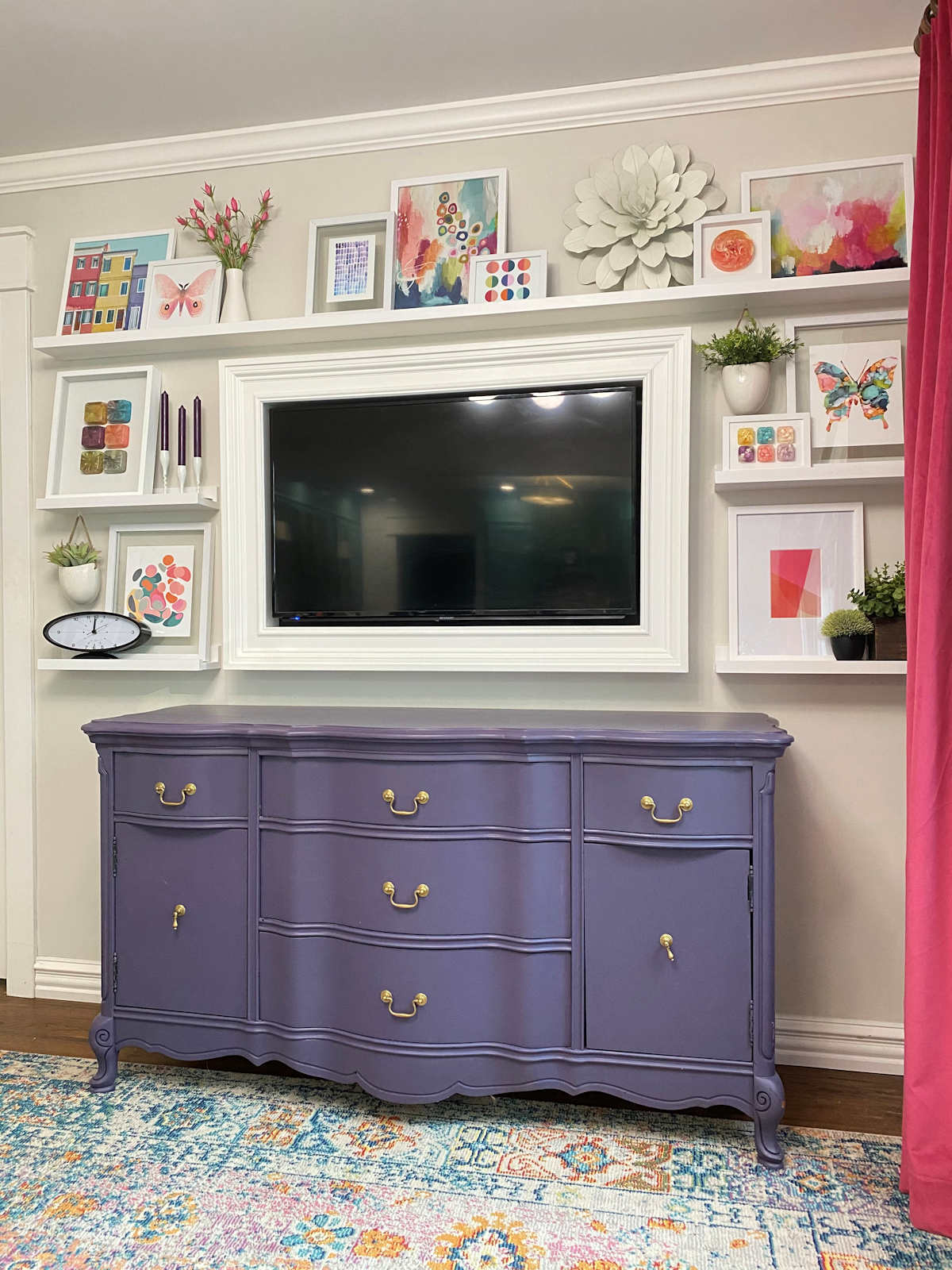
And if I’m being completely honest, the new still hasn’t worn off of the music room bookcases, either. It brings a smile to my face to walk through that room and see those shelves filled with such colorful items.
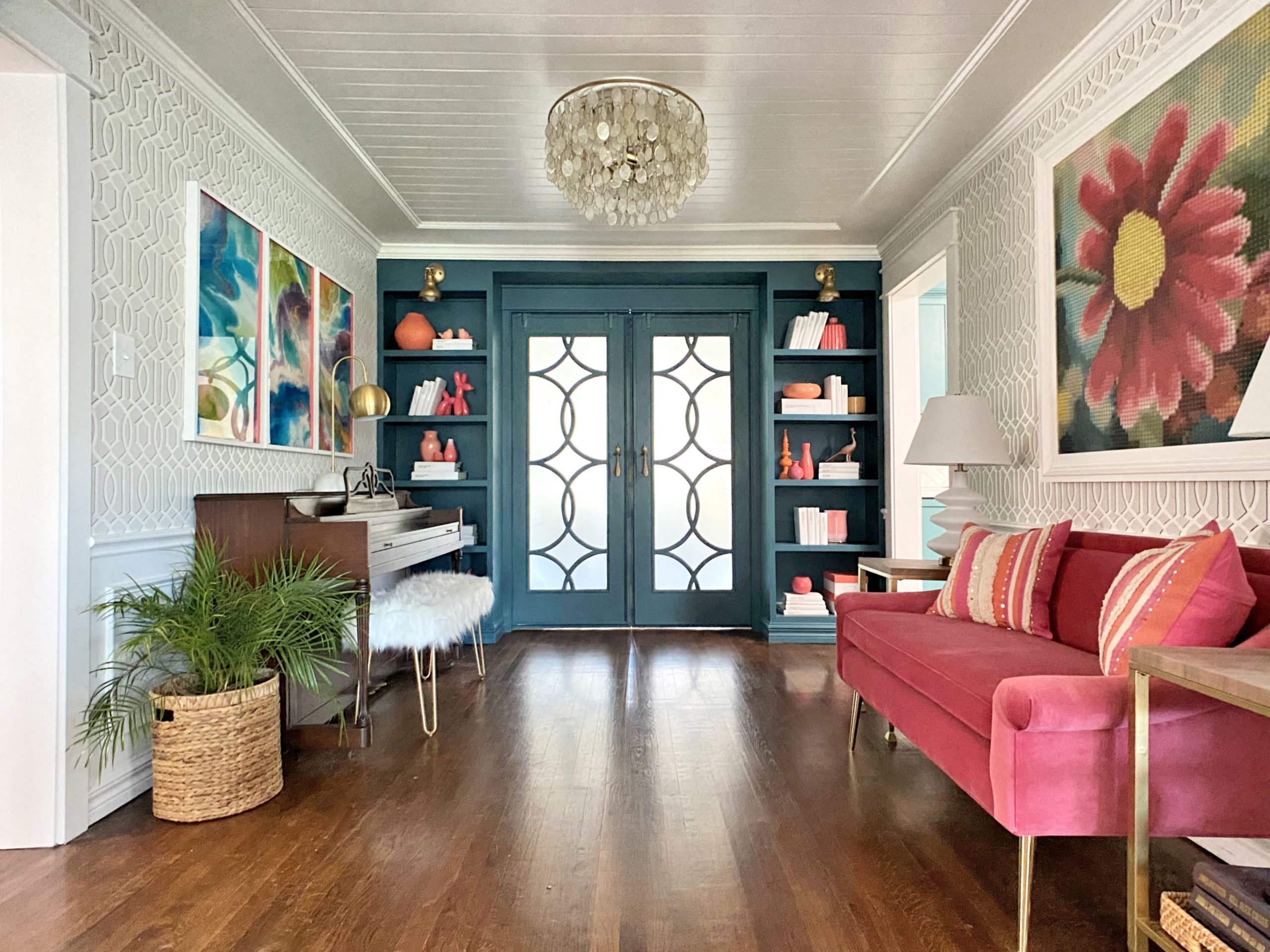
I love decorating shelves, but it can be a challenge sometimes to get things looking balanced and eye-pleasing, especially for someone like me who would rather everything just be perfectly symmetrical. Perfect symmetry doesn’t really work on bookcases, shelves, and picture ledges, so sometimes it takes me a bit longer to find arrangements that are asymmetrical while still looking balanced.
I’ve learned a few tips over the years that have helped me, so I wanted to pass those along to you in case you struggle with this sometimes as well. Note that none of these are hard and fast rules. But if you have a bookcase or shelves that don’t quite look right, you can try to incorporate a few of these tips and see how that works out for you.
1. Groupings in odd numbers are pleasing to the eye.
We’ve all heard this, right? And I can tell you that it’s true! In fact, odd numbers (and for some reason, three in particular) when decorating something like bookcases and shelves are so naturally pleasing to the eye that I do it without even realizing it. When I was placing things on our new picture ledges, I was just bebopping along and arranging things, moving things around, adding things, removing things, until everything looked balanced to my eye.
And what did I end up with? Groupings of threes on every single ledge, with three groupings of three on the top long ledge. I didn’t plan that, and it wasn’t intentional. It’s just what looked balanced and pleasing to me.

On the music room bookcases, more times than not, I wound up with odd numbers as well. I have a few shelves with one large colorful item, other shelves with groups of three, and only a couple of shelves with two colorful items.
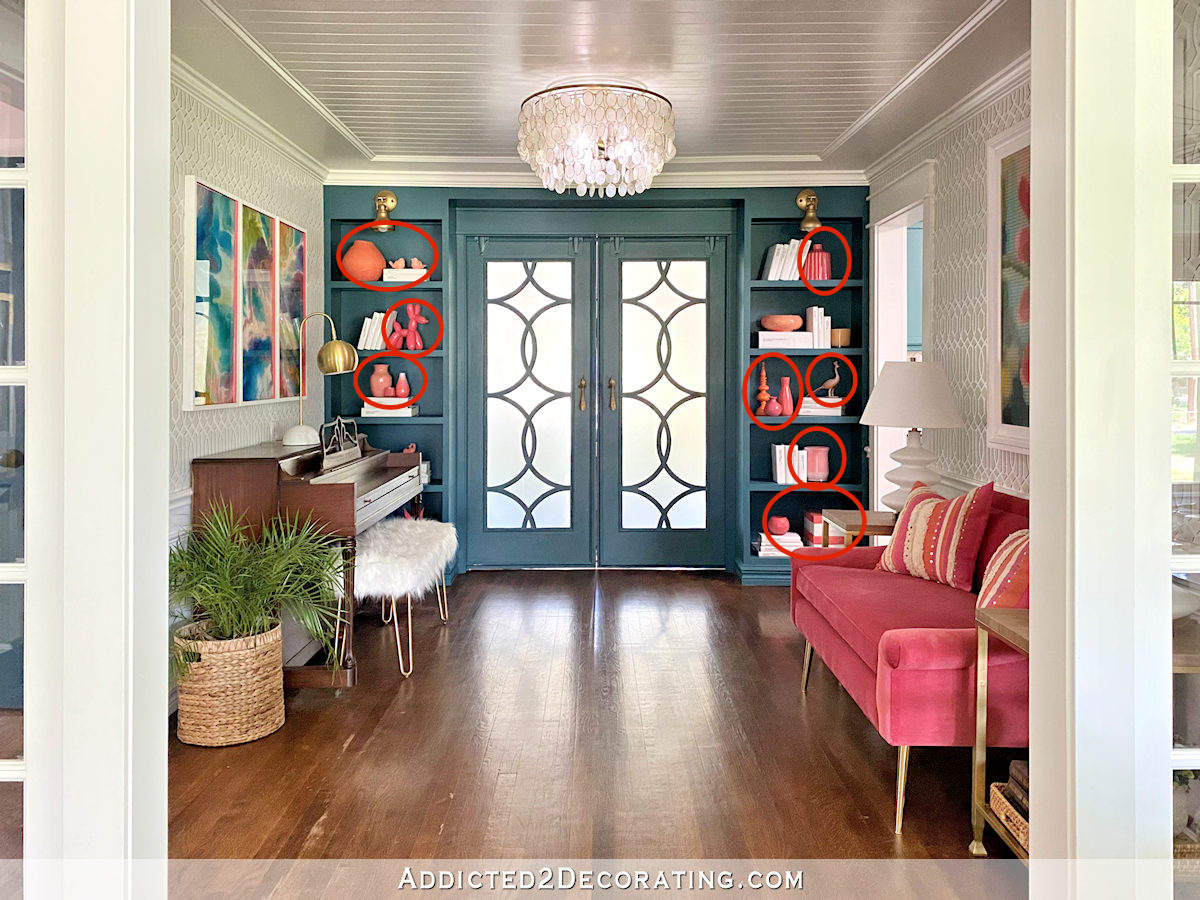
But like I said, it’s not a hard and fast rule. Just use that as a guideline if something doesn’t look quite right. But if you have a pair of items that looks right to you (like my one shelf above with only two colorful items on it), then obviously there’s no reason to change it.
2. Leave some breathing room.
When I started out arranging the picture ledges in the sitting room, my very first attempt at the top shelf had stuff all the way across from one end to the other, with no breaks at all. It gave that shelf a very cluttered look, which you can see here. (Please excuse my light that keeps falling from the ceiling.)
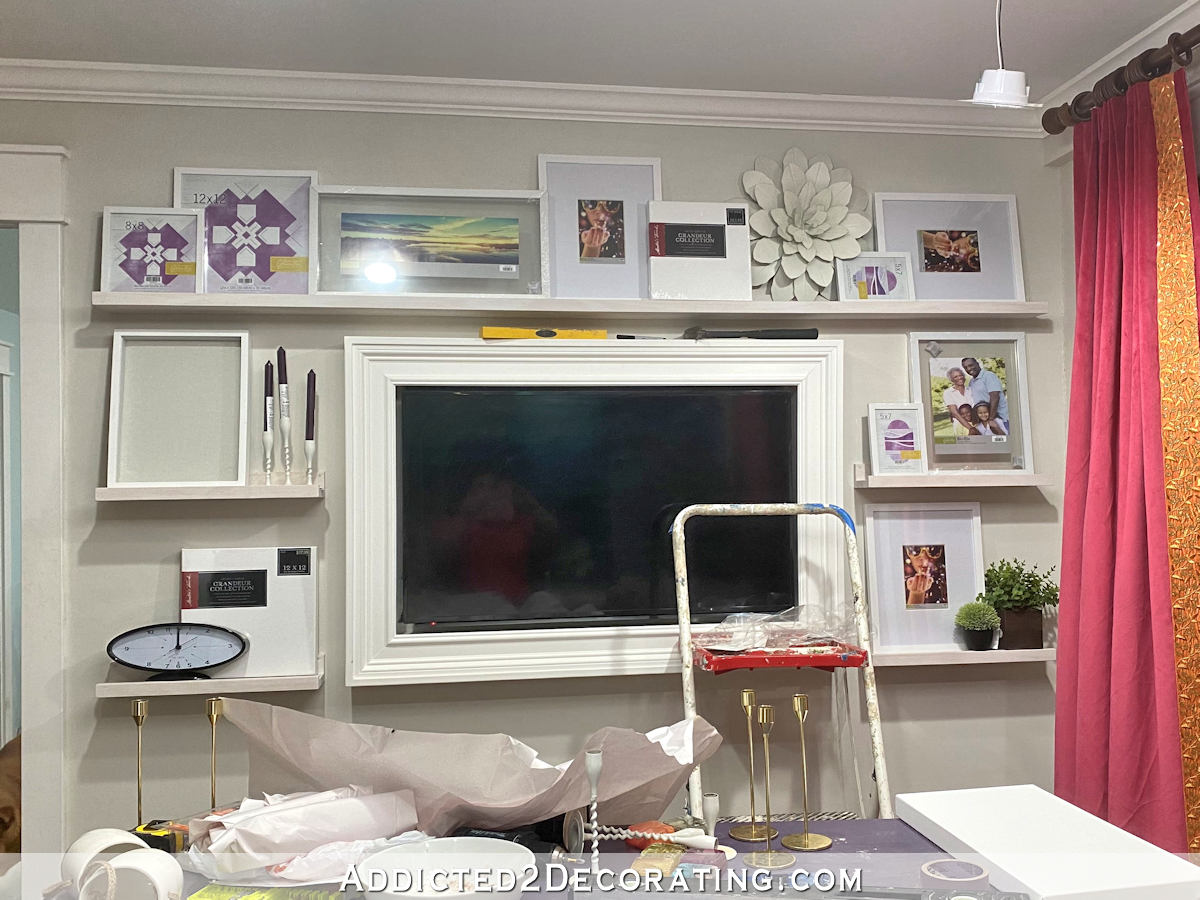
I got a little frustrated with it, took a picture to see if I could pinpoint what was wrong with it, and took a break for a while. When I came back, it seemed very obvious what the problem was. I needed to give the items some space. So I layered a grouping, made a space, layered another grouping, made a space, and layered one last grouping. That looked so much better and much less cluttered.
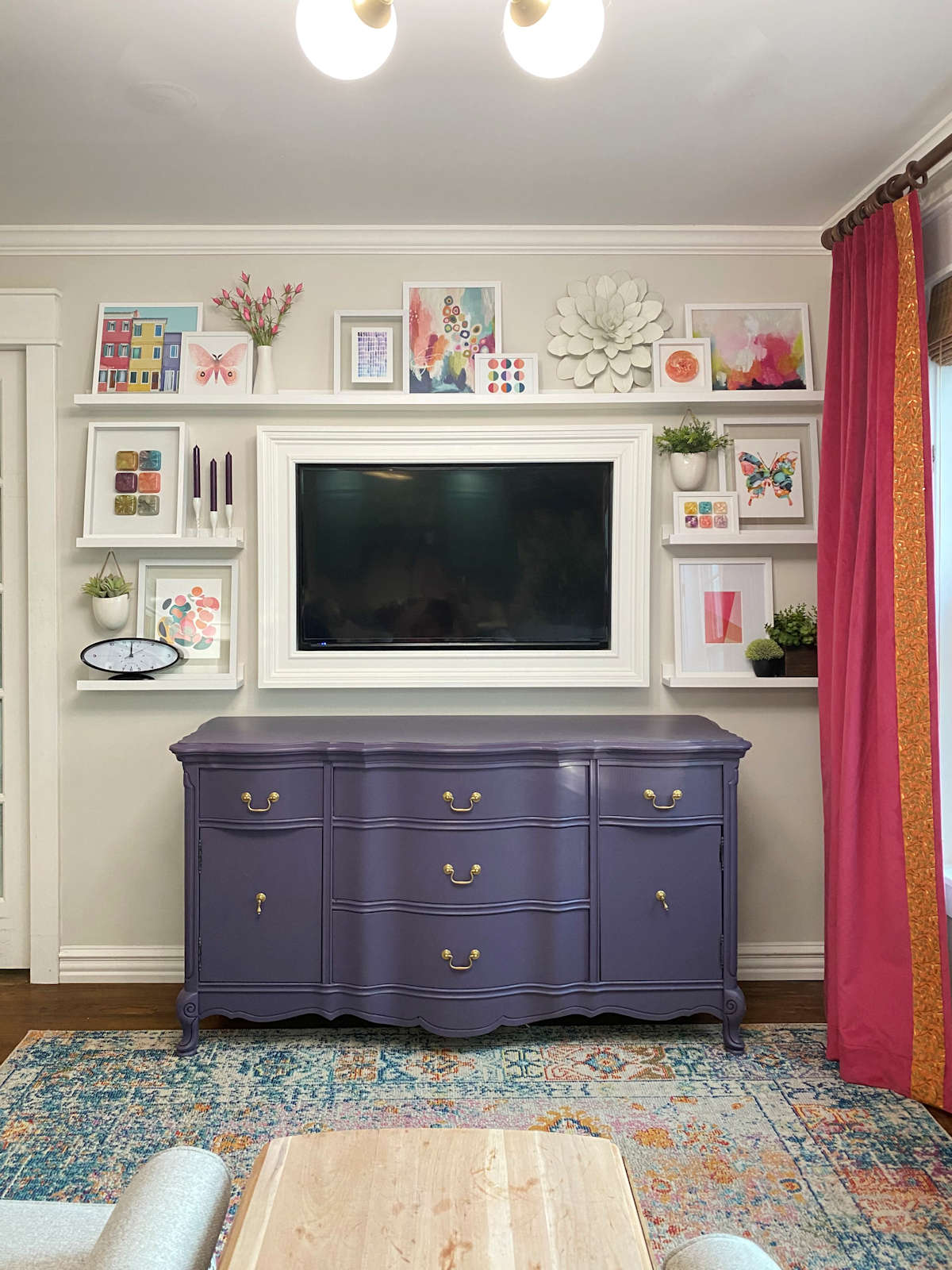
On the music room shelves, I also tried to leave some breathing room on most of the shelves. There’s no need to pack a shelf full from one side to the other. I mean, you can certainly do that on a few, but there’s no need for every single shelf to be packed full. These bookcases have plenty of breathing room.
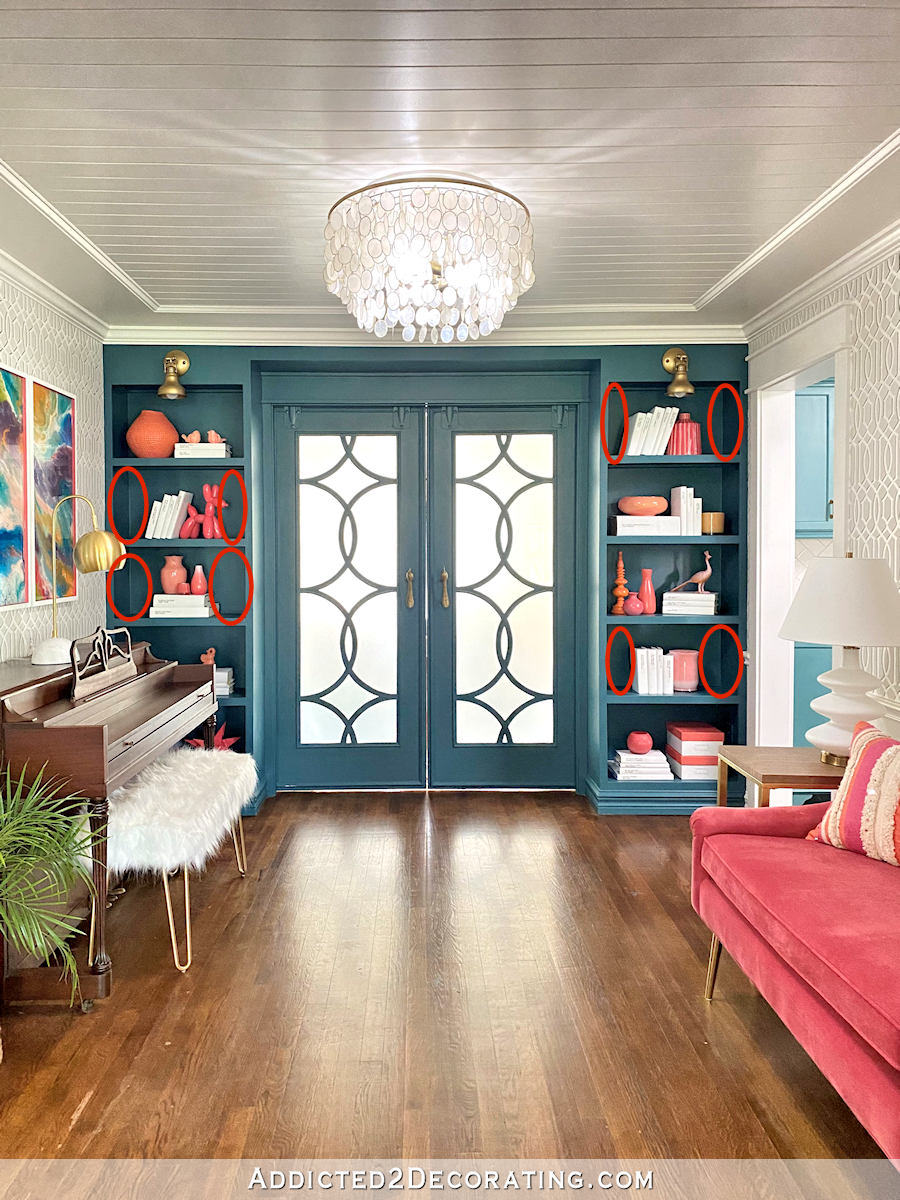
3. Vary the height of the items.
As a general rule, varying the height of the items on the shelves is going to produce a much more interesting collection than if you fill your shelves with items that are all the same height. This is kind of common sense, and yet it’s something I find challenging almost every single time I start decorating shelves. In fact, you can see that it was a bit more of a challenge for me on the music room bookcases, but I did seem to manage a bit better (and in my opinion, end up with a better result) on the sitting room picture ledges.
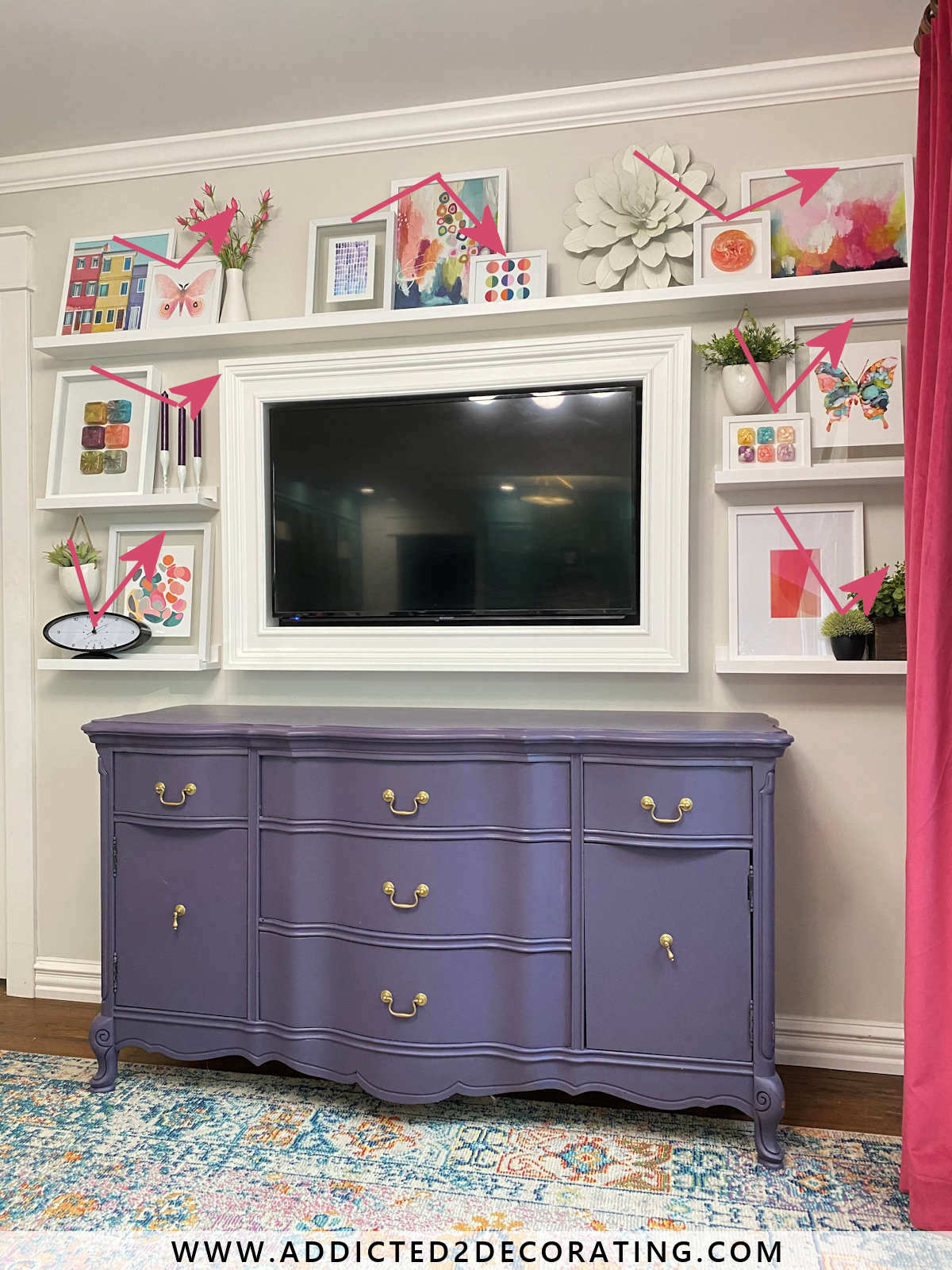
I find that it looks so much better if you don’t have items of the same height lined up right next to each other. Of course, there are always exceptions to this. So again, this is not a hard and fast rule. It’s just something to keep in mind if you’re struggling to get your shelves to look right. See if you have items of the same height lined up next to each other, and if so, try spacing them apart with items of varying height in between and see how that works.
4. Not everything has to sit on the shelves.
Keep in mind that just because you’re decorating shelves, that doesn’t mean that every single item you use has to actually sit on the shelves. For example, on the picture ledges, I used two hanging planters in the arrangements on two of the shelves.
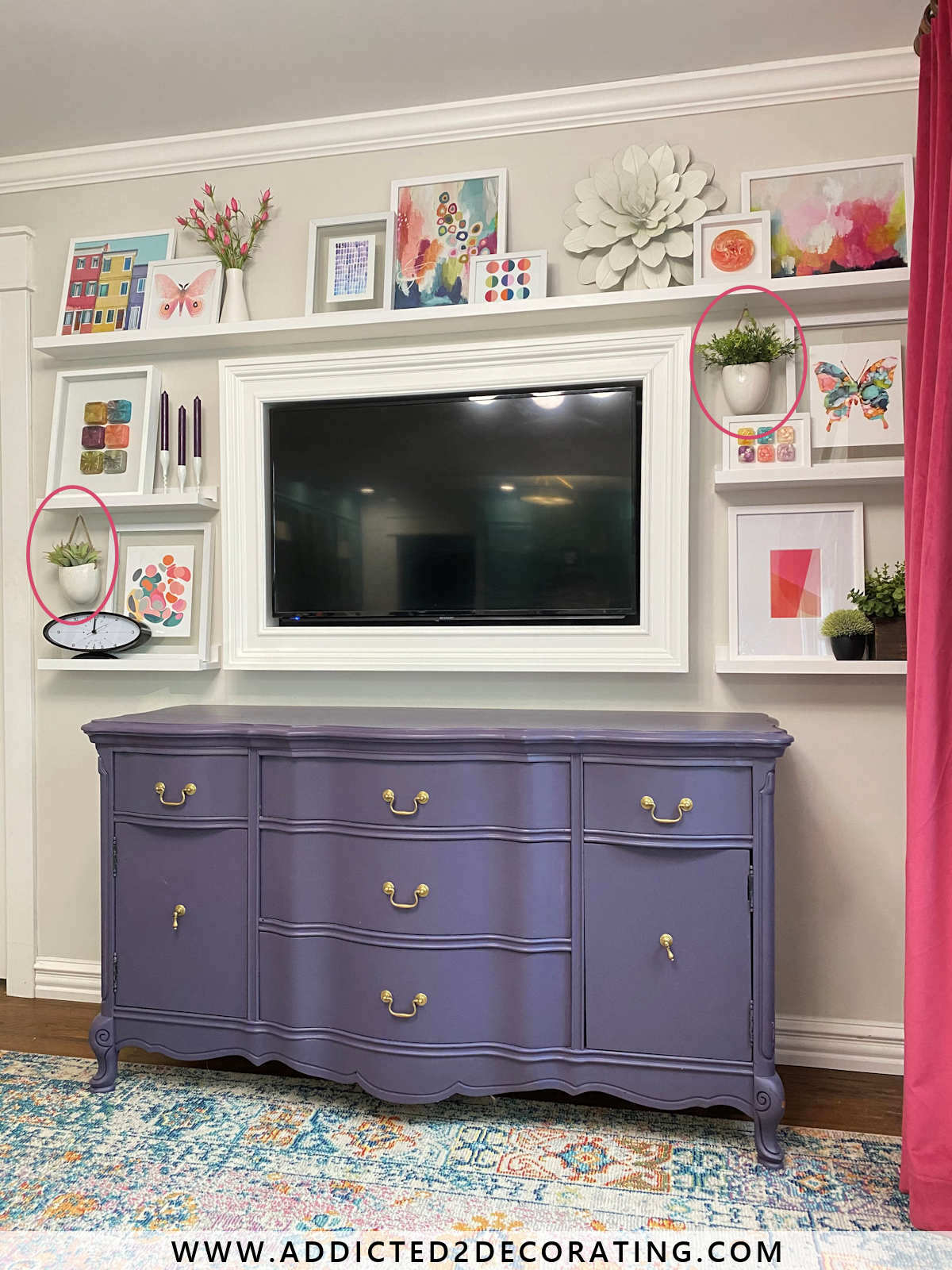
And on the shelves in the hallway bathroom, I hung a piece of artwork above one of the shelves instead of setting it on the shelf. This gave more varying heights to the shelf than I could have created by placing the artwork on the shelf or even on an easel.
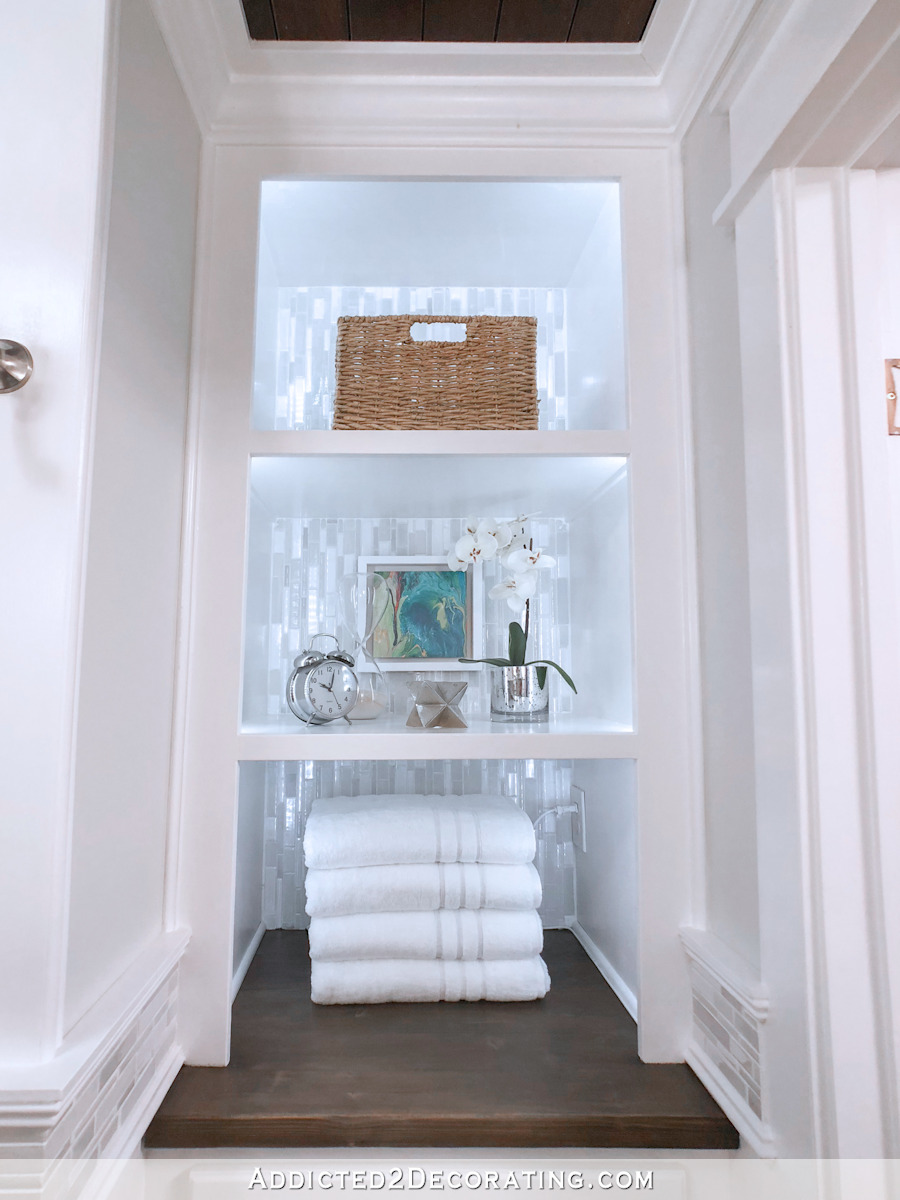
5. Use books on bookcases.
This is a personal pet peeve of mine, and it’s completely a personal thing. But since these are my tips, I’m adding it. 😀
If you’re decorating bookcases, add books. Even if you’re not a big reader, go to the used bookstore and pick up some books for your bookcases. They add interest. You can use them to add height to your items you want to show off. And the word is literally in the name. They’re bookcases. 😀 And if you’re just wanting to use them to decorate, vary the placement from shelf to shelf, and make sure that they’re not perfectly lined up from one shelf to the next.
You can see on the music room bookcases that I have some upright, some lying flat, some leaning out, some leaning in. And from shelf to shelf, the placement is varied.
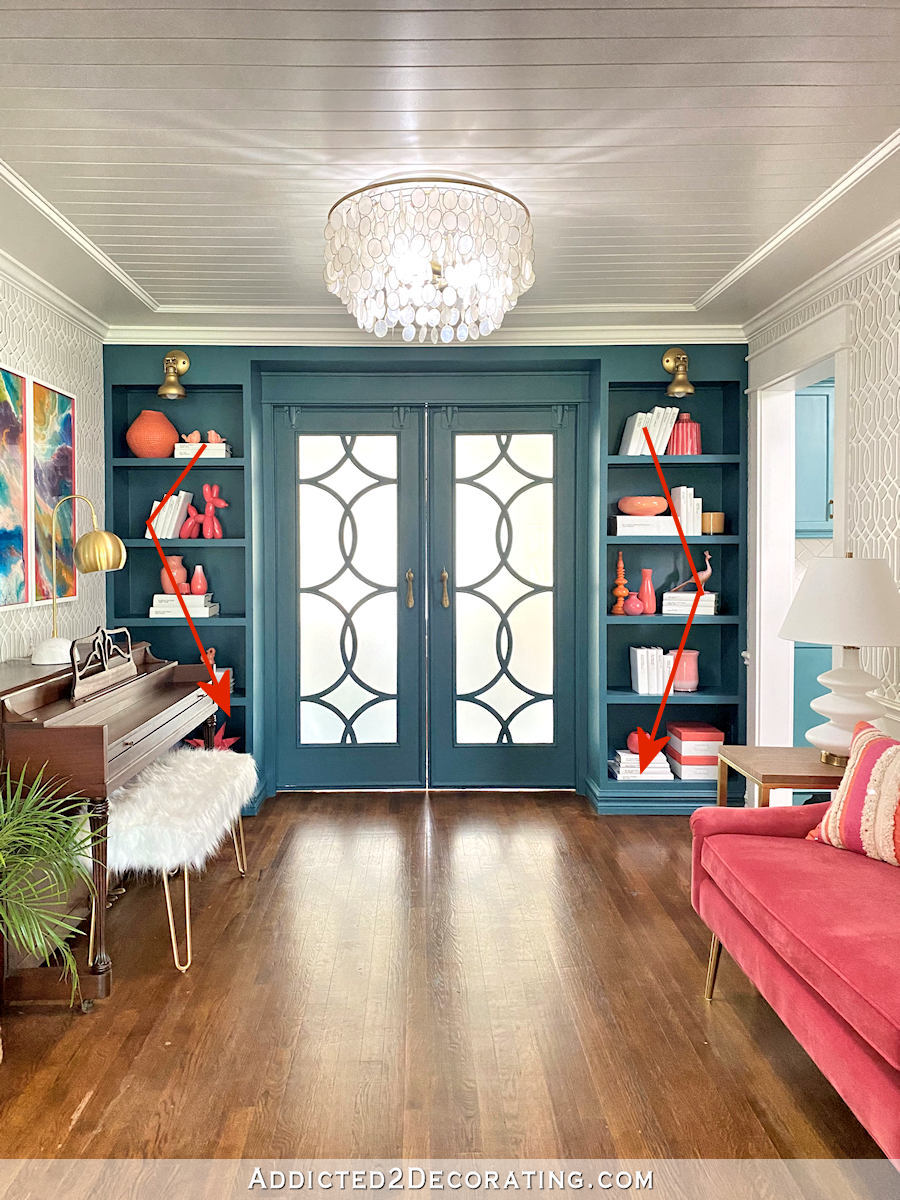
I’ve walked into so many homes over the years (and I see this very often in open houses and model homes) where the bookcases are filled with nothing but tchotchkes from side to side, top to bottom. To my eye, when bookcases and shelves are nothing but tchotchkes, things blend together and it becomes harder to appreciate any of the decorative items. Books provide a resting place for the eye and spread out the decorative items so that they can be seen easier and appreciated more.
Once again, there are exceptions to these tips. I’ve seen some bookcases and shelves that were dedicated exclusively to the display of a beautiful collection, like white ironware dishes from side to side and top to bottom, or nothing but colorful glassware. Shelves and bookcases dedicated to collections obviously don’t need books. 🙂
And finally…
6. If you’re a bibliophile…
Completely ignore everything I said about decorating bookcases. 😀 I know for you bibliophiles out there — those of you who have collections of hundreds of books that you’ve actually read and treasure — people like me who are all about the decorative and the pretty, who cover our books in white paper because we think that the colors of the spines are distracting, and who go to used bookstores to purchase books that we’ll never read to serve decorative purposes only, are a real source of frustration. I get it. So if that describes you, forget the decorative stuff. Forget the “breathing room”. Forget the “varying the heights and arrangements of books from shelf to shelf” thought. You do you, and you stuff those shelves from side to side, top to bottom, with the books you love and treasure. Because I know that you get just as much enjoyment out of seeing your bookcases stuffed with those treasures as I do seeing my picture ledges filled with colorful artwork. 🙂
Addicted 2 Decorating is where I share my DIY and decorating journey as I remodel and decorate the 1948 fixer upper that my husband, Matt, and I bought in 2013. Matt has M.S. and is unable to do physical work, so I do the majority of the work on the house by myself. You can learn more about me here.



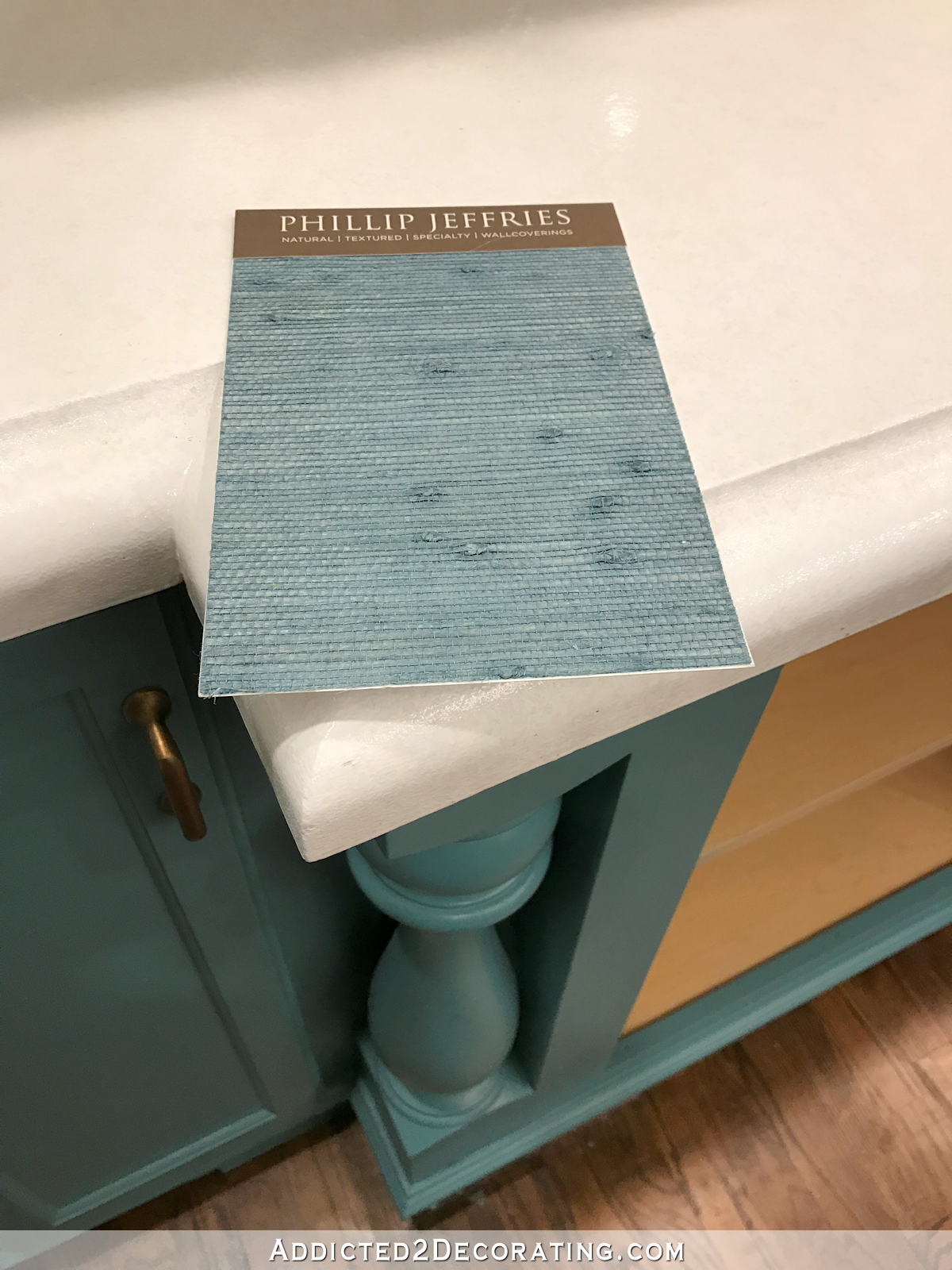
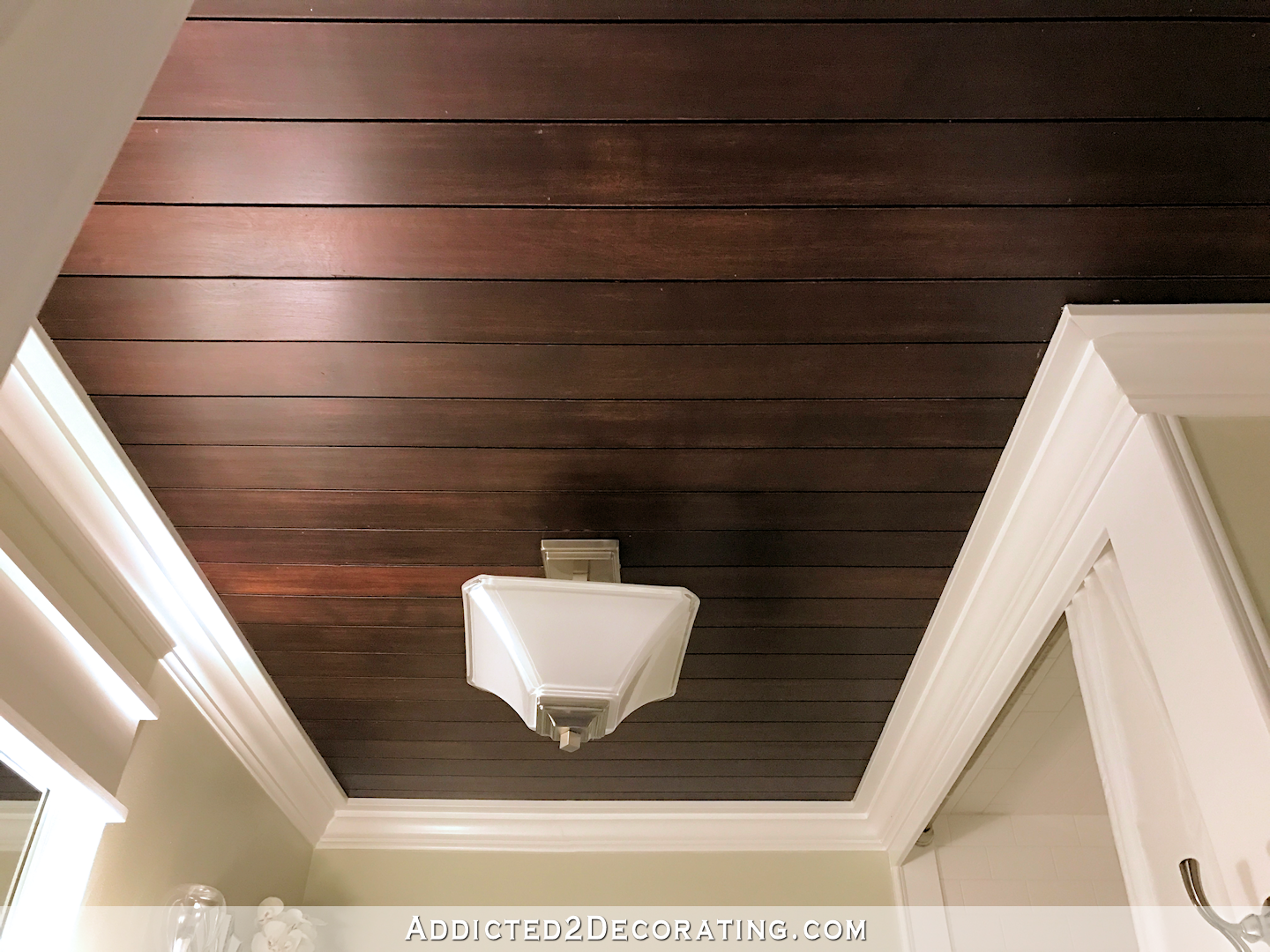
Kristi, you are the MASTER when it comes to decorating shelves, book cases and picture ledges. I had to keep scrolling over your pictures because I absolutely loved what you selected and how you placed them. Your share suggestions give a comprehensive guideline so that we all can decorate our own shelves and love the results. Thank you!
The pictures of your rooms make me smile every time I see them! Your new wall with picture ledges, as well as your music room, make me drool. I see warmth and happiness wherever I look.
Beautiful! The rule of threes (or odd numbers) applies to outdoor shrubs as well I’ve learned.
I love this room and the shelves. The pink sorbet sofa and purple dresser are exquisite. Congratulations on putting together such a delightful area.
Wow – what great tips! I still absolutely LOVE the way you did those ledges…They please my eye better than anything I have seen in a while. I hope I can do as well in the future. Meanwhile, I am struck by the shelves in your hall bath. How did I miss that? I don’t remember seeing that before – is there a light in there? Or, is it just reflection off that tile?
I’m going to look for a picture of that from your archives! Thanks again for the tips.
There are LED tape lights lighting up the shelves.
Super cute!
I love your blog and check it every day. You have taught me so much! Because of you, I no longer have orange oak cabinets because I followed your directions for painting cabinets. When I had my countertops installed, the workers thought I’d hired a professional. Thank you!
Your displays are lovely and your tips are great! I can’t wait until you can devote more time to your own art work. That display could easily consist of all items made by you.
One tip I use (and you kind of mentioned) is to take a picture of the display. I have done this many times, and it really helps me pinpoint the imbalance. Sometimes it’s form, sometimes it’s color, but what I don’t see in person pops out in the picture.
Along with the rule of three, is to look for triangles. So maybe you have three red items scattered among the shelves. Or three round ones. Something that your eye can pick out and form a triangle. Repeating shapes or colors that help your eye travel in a kind of scavenger hunt!
There are so many little tricks, but the biggest thing is to just try things. I change out my bookcases every season, and it used to take me forever. Now it goes much faster, because my eye is better trained. It’s not effortless yet, but much easier than it used to be!
Rebecca, what great ideas! Thank you. I loved the idea of taking a picture to get the perspective of balance. I am going to copy and past your comment in my “idea” notebook.
Thank you, Elaine! You just made my day!
This might seem strange to some, but when I get stuck on placement of items or when I just can’t quite pinpoint what’s wrong with a room or a shelf, etc., I’ll take a hand mirror and hold it by my head so I can see the area through the mirror backwards. It just gives a way to see things from a different perspective. Works every time.
Very smart! And that doesn’t seem strange to me at all. I grew up with an artist mom. Any time something wasn’t quite looking right on the painting she was working on, and she couldn’t pinpoint the problem, she would take it to the bathroom and look at it in the mirror. Seeing that different perspective would often help her see exactly what the issue was.
Thank you for adding No. 6 – I was reading the post and thought: but where do I put my myriad books???? So that last item on your list put a big smile on my face and made me chuckle! I try to squeeze in some decorations among the books, but after some time they get covered and hidden in books. I’ve learnt that this is me and have developed patience for it. There are other places which I can decorate and I will def bear your rule of three in mind for that!
I especially love the part for bibliophiles. 🙂 Thank you for remembering us. Have a blessed day!
Welp, I’m off to tweak my bookcases and ponder how to display the fall decor that is going to be coming out in a couple of weeks. Your shelves are perfection.
Your last point made me laugh, because my husband and I are definitely bibliophiles, and as I was reading through your very informative and helpful post, I was thinking, “Gosh, she’s got so many good tips, but I am just annoyed by those white paper-covered books.” Lol. I like my bookshelves with their colourful and slightly chaotic plethora of books. Mind you, our main focal point bookcase is very carefully organized and curated… and the kids’ bookshelves easily get a little *too* chaotic. And now I’ll have to think about actually decorating our bookshelves with stuff instead of books, because my husband is starting a new job, and he’ll be taking a bunch of his books to his new office. Yikes. Sticking books on shelves is easy, decorating is harder, so really, your post was super helpful, and timely!
Yes, I’m one of those bibliophiles, too. 🙂 I try to at least pick a shelf at eye level to arrange with *special* books and treasures, but that’s all falling apart with a book-loving toddler on the loose. Now, moderately special lower shelf books are heaped unceremoniously on special books. Oh well. 🙂 In the meantime, thank you for letting us rest our eyes on yours.
Your decorating is sooo colorful and pleasing to the eye. I’m planning to take photos of some of my wall and bookcases and analyse space, angles, numbers, etc. Sometimes the littlest tweak can make such a big change. Thanks.
I do both, I have fairly extensive collection of books that I read/re-read and most of my shelves are filled side to side with books. But I have a few where I will add a small piece of art or a tchotchke. I also have the tops decorated like a picture ledge and then a random shelf in the middle has something other than books. I really like to have my collection where I can see it, but I also like to “pretty” it up a bit 🙂
Great tips. On the different height bit. In visual merchandising it’s the pyramid principal, if you look at the arrows you drew to show the heights you can see your pyramids and inverted pyramids. On the music room shelves there’s less pyramids which could be why you feel you achieved it better on your newer shelves.
Kristi, do you have a specific way you cover your books in paper? Or do you just cut to size and wrap/fold inwards so the paper is held in place by the closed book?
I actually did a tutorial a very long time ago on how I cover books: https://www.addicted2decorating.com/d-i-y-project-paper-book-jacket.html